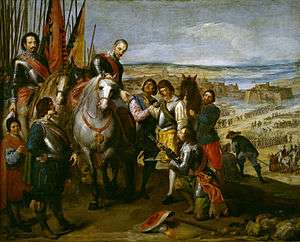José Leonardo

| Wikimedia Commons has media related to Jusepe Leonardo. |
José Leonardo, known also as Jusepe Leonardo (Calatayud, 1601 – Zaragoza, 1652), was a Spanish painter of the Baroque period, active during his maturity in the royal court in Madrid.[1][2][3]
Biography
Leonardo was born at Calatayud in the Province of Zaragoza, and was a pupil of Eugenio Caxés. He trained with Pedro de las Cuevas, and became known for his battle paintings.[4] He was painter to the king, and executed for the palace of Buen Retiro works worthy of celebrity; among them the Surrender of Juliers and the March of the Duke of Feria‘s Troop upon Acqui. There is also a portrait of Alaric the Goth in the Royal collections.
Leonardo was one of the artists used to decorate the Royal Alcazar of Madrid, restored by King Philip IV of Spain. Félix Castello and Leonardo painted the vaults of the Sacristy of the Royal Chapel. He was unable to finish the Reliquary in the same chapel and, in 1648, another painter was contracted. He apparently became an alcoholic, demented, and died at Zaragoza.[5][6] His enemies were accused of having poisoned him.[7]
References
- ↑ Spanish paintings in the National Gallery of Ireland National Gallery of Ireland, Rosemarie Mulcahy 1988 -p31 "Jose Leonardo Calatayud (Aragon) 1601-c.1652 Zaragoza Jose Leonardo was baptised in the church of San Andres, Calatayud on 21 March 1601.
- ↑ Spanish artists from the fourth to the twentieth century 1996 - 201 "Leonardo, Jusepe (or José) 1601-1652"
- ↑ "Jose Leonardo". Biografías y Vidas (in Spanish). Retrieved 8 May 2013.
- ↑ "La toma de Brisach". Salón de Reinos (in Spanish). Centro Virtual Cervantes. Retrieved 8 May 2013.
- ↑ "Leonardo, José o Jusepe". La página del Arte y la Cultura en Español (in Spanish). Junta de Castilla y León. Retrieved 8 May 2013.
- ↑ Madrazo y Kunz, Pedro de (1872). Catálogo Descriptivo e Histórico del Museo del Prado de Madrid (Parte Primera: Escuelas Italianas y Españolas) (in Spanish). Calle del Duque de Osuna #3, Madrid; Original from Oxford University, Digitized May 1, 2007: M. Rivadeneyra. pp. 426–427. Retrieved 8 May 2013.
- ↑ Bryan, Michael (1889). Walter Armstrong & Robert Edmund Graves, ed. Dictionary of Painters and Engravers, Biographical and Critical (Volume II L-Z). York St. #4, Covent Garden, London; Original from Fogg Library, Digitized May 18, 2007: George Bell and Sons. p. 43.